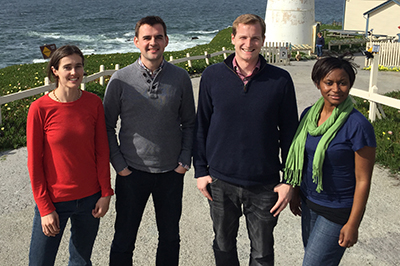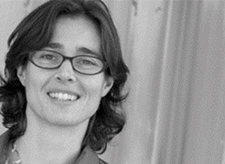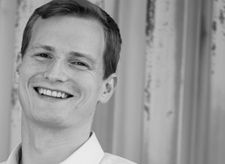

 |
 |
|
|||||||||||||
 GCEP Quarterly Newsletter
Newsletter Sign-Up
News Archive
GCEP Quarterly Newsletter
Newsletter Sign-Up
News Archive
|
GCEP alumni land key roles in new energy effort at Berkeley Lab

GCEP alumni Kendra Kuhl, Dan Riley, Jared Schwede and Etosha Cave
(left to right) at a Cyclotron Road retreat event. Photo courtesy: Sebastien Lounis GCEP student alumni Kendra Kuhl, Etosha Cave, Jared Schwede and Dan Riley have been selected as project leads for Cyclotron Road, a Berkeley Lab program that is taking a new approach to helping next-generation energy technologies make the transition from laboratory research to market readiness. The GCEP standouts from Stanford are four of the first set of eight “top entrepreneurial researchers” chosen for this effort. With $500,000 in salary and seed funding over two years at Berkeley Lab, each project team works on developing their innovative energy technology idea, establishing collaborations within the world-class lab, and securing outside support and funding to further drive their research vision. The program bridges academia, government funding and industry, a unique space where technical savvy and an entrepreneurial spirit could eventually pay off for these young scientists. Named for the street in Berkeley where the lab is located, Cyclotron Road has been hailed as an “incubator for innovation” by the New York Times and as part of a “new renaissance emerging for energy innovation” by GigaOm. We caught up with each of the GCEP alumni to find out what role GCEP played in landing this entrepreneurial research opportunity at Berkeley Lab. Kendra Kuhl and Etosha Cave: Electrochemistry 
Kendra Kuhl
"GCEP funding allowed me to start working in the area of electrochemical CO2 reduction as a graduate student in
Prof. Thomas Jaramillo's lab and contributed to continuing that work with Prof. Anders Nilsson as a postdoc. GCEP provided invaluable opportunities to connect with other researchers, develop communication skills and explore the wider clean energy landscape, which ultimately led me to
the Cyclotron Road program."
-Kendra Kuhl Kendra received a B.S. in chemistry from the University of Montana and a Ph.D. in chemistry from Stanford, where she worked with GCEP investigator Thomas Jaramillo examining carbon dioxide (CO2) conversion catalysts. In 2012, she was honored as a GCEP Distinguished Student Lecturer. Kendra was also a postdoctoral researcher with GCEP investigator Anders Nilsson at the SLAC National Accelerator Laboratory focusing on in situ catalyst characterization and the effect of surface morphology on catalyst activity. 
Etosha Cave
"The interdisciplinary aspect of GCEP enabled me to combine my research interests in engineering and chemistry and find a unique niche. The research in the Jaramillo lab laid the groundwork for landing this incredible job at Berkeley Lab while still pursuing my Ph.D. at Stanford."
-Etosha Cave Etosha received a B.S. in engineering from the Franklin W. Olin College of Engineering and an M.S. in mechanical engineering from Stanford. Her GCEP-funded research focused on CO2 electroreduction on metal surfaces. She is currently finishing a Ph.D. in mechanical engineering at Stanford working with GCEP investigator Thomas Jaramillo in the Chemical Engineering Department. At Cyclotron Road, both Etosha and Kendra lead a project focused on pilot-scale deployment of electrochemical CO2 conversion by developing innovative reactor designs and catalysts for converting CO2 to ethanol and other products. Jared Schwede and Dan Riley: Thermionic Energy 
Jared Schwede
"GCEP was one of the first programs to fund our out-of-the box PETE research. In addition, the emphasis GCEP places on student development was very important during my Ph.D. studies. I feel very lucky to have taken part in the student speaker series and to have had the opportunity to speak in front of the annual GCEP research symposium as a Distinguished Student Lecturer."
-Jared Schwede Jared holds a B.S. in physics from Yale and recently completed his Ph.D. in physics at Stanford. At Stanford, he worked with GCEP investigators Nicholas Melosh and Zhi-Xun Shen on a breakout solar-energy technology called photon-enhanced thermionic emission (PETE). In 2011, Jared was honored as a GCEP Distinguished Student Lecturer. 
Dan Riley
"Thanks to GCEP funding the PETE research, I was given the rare opportunity to work on a fundamentally new, breakthrough energy conversion process. The PETE project then sparked a huge amount of interest in thermionics which contributed to Cyclotron Road’s decision to support our work in this area.”
-Dan Riley Dan received a B.S.E. in engineering physics from Case Western Reserve University and is currently finishing his Ph.D. in the Physics Department at Stanford. He collaborated with GCEP investigators Nicholas Melosh, Zhi-Xun Shen and Roger Howe on improving the efficiency of PETE technology. At Cyclotron Road, both Dan and Jared lead the project focused on high-efficiency, compact direct heat-to-electricity conversion devices known as thermionic energy converters. Photos courtesy: Sebastien Lounis March 18, 2015 |
| Restricted Use of Materials from GCEP Site: User may download materials from GCEP site only for User's own personal, non-commercial use. User may not otherwise copy, reproduce, retransmit, distribute, publish, commercially exploit or otherwise transfer any material without obtaining prior GCEP or author approval. |